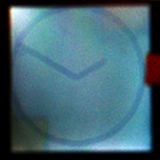Table of Contents
Shortnote
The perl script below uses the BV4141 display controller in order to draw the current time onto the BV4141 display. The image shows the time 2:50.
Calculations
The equation of the circle gives us any mobile point on the perimeter of a circle centered in  and radius
and radius  . The equations to obtain the points on the perimeter of the circle are as follows:
. The equations to obtain the points on the perimeter of the circle are as follows:

where  represents an angle, measured counter-clockwise on the circle (following trigonometric rules).
represents an angle, measured counter-clockwise on the circle (following trigonometric rules).
We know that, for clocks, the hours divide the clock-face into  equal angles, such that every
equal angles, such that every  , when divided corresponds to
, when divided corresponds to  . Conversely, for hours, the clock-face is divided into
. Conversely, for hours, the clock-face is divided into  equal angles, such that every
equal angles, such that every  , when divided corresponds to
, when divided corresponds to  .
.
We also know that the starting point of the clock is at 12 hours sharp and continues to grow, clockwise, to 1, 2 and so on. Thus, every clock-wise step can be considered as an addition of  angles, such that hour
angles, such that hour 1 represents  , hour
, hour 2 represents  .
.
The problem is when we reach hour 4, because  gives us a negative angle
gives us a negative angle  . For that, we use modulo arithmetic:
. For that, we use modulo arithmetic:  in order to wrap the value back to positive values.
in order to wrap the value back to positive values.
Code
The code requires that the BV4141 display controller is copied into the $PATH of the user running this script. This can be done by just copying vacctl.pl to /usr/local/bin (preferably) or /usr/bin.
- vacclock.pl
#!/usr/bin/perl ########################################################################### ## Copyright (C) Wizardry and Steamworks 2012 - License: GNU GPLv3 ## ## Please see: http://www.gnu.org/licenses/gpl.html for legal details, ## ## rights of fair usage, the disclaimer and warranty conditions. ## ########################################################################### # Returns the angles that correspond to the current # number of hours and minutes. It does that by using # clock arithmetic and wrapping the angles into a circle. # For hours, the clock face divides into 12 equal # angles.For minutes, the clock face divides into 60 # equal angles. sub angles { my @time = split(/:/, shift); return %a = ( 'h' => (90-$time[0]*360/12) % 360, 'm' => (90-$time[1]*360/60) % 360 ); } my $pi = 3.14159265358979; sub deg_to_rad { ($_[0]/180) * $pi } sub rad_to_deg { ($_[0]/$pi) * 180 } # Get hour and minutes. @time = ((localtime)[2],(localtime)[1]); # If military time, change to conventional time. if($hour > 12) { $hour -= 12; } # Get the angles corresponding to the current time. %a = &angles("$time[0]:$time[1]"); # x,y for hours. @xy_h=(int(62+32*cos(deg_to_rad($a{'h'}))), int(62+32*sin(deg_to_rad($a{'h'})))); # x,y for minutes. @xy_m=(int(62+62*cos(deg_to_rad($a{'m'}))), int(62+62*sin(deg_to_rad($a{'m'})))); # Clear display. `vacctl.pl --clear`; # Draw clock face. `vacctl.pl --circle=62,62,62`; # Draw hours. `vacctl.pl --line=62,62,$xy_h[0],$xy_h[1]`; # Draw minutes. `vacctl.pl --line=62,62,$xy_m[0],$xy_m[1]`;
